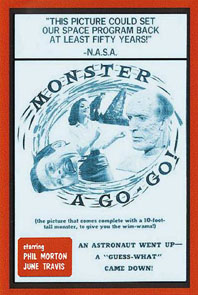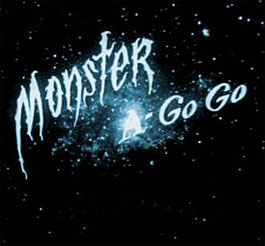Forgotten Horrors: Monster A Go-Go!
 Bad movie fans and critics alike often site Ed Wood’s legendary Plan 9 from Outer Space as the worst film of all time. They certainly have an argument based on writing, acting, directing, and just about every other conventional film element but one thing you can say for Plan 9, it was completed by the same crew that started it. In 1961, Wisconsin cult filmmaker Bill Rebane began production on a modest science fiction feature titled Terror at Half Day. Unfortunately, he ran out of funding somewhere around the 80% completed mark and filming was stopped. Four years later, another cult filmmaker, Herschell Gordon Lewis, was looking for a co-feature for his film Moonshine Mountain when he discovered the remains of Terror in a lab. Lewis, who had served as photographer on some of this footage, proceeded to cobble together everything he could salvage and filmed only the minimum amount of new material necessary to pad it out to feature length, a mercifully brief 65 minutes! According to the ad campaign for the retitled Monster a Go-Go, “an astronaut went up – a ‘guess what’ came down!” and a WTF? is what we ended up with!
Bad movie fans and critics alike often site Ed Wood’s legendary Plan 9 from Outer Space as the worst film of all time. They certainly have an argument based on writing, acting, directing, and just about every other conventional film element but one thing you can say for Plan 9, it was completed by the same crew that started it. In 1961, Wisconsin cult filmmaker Bill Rebane began production on a modest science fiction feature titled Terror at Half Day. Unfortunately, he ran out of funding somewhere around the 80% completed mark and filming was stopped. Four years later, another cult filmmaker, Herschell Gordon Lewis, was looking for a co-feature for his film Moonshine Mountain when he discovered the remains of Terror in a lab. Lewis, who had served as photographer on some of this footage, proceeded to cobble together everything he could salvage and filmed only the minimum amount of new material necessary to pad it out to feature length, a mercifully brief 65 minutes! According to the ad campaign for the retitled Monster a Go-Go, “an astronaut went up – a ‘guess what’ came down!” and a WTF? is what we ended up with!
Underscoring the film’s schizophrenic nature, the plot manages to somehow be both simplistic and convoluted at the same time. A capsule returning to Earth from a manned space flight goes off course and crash lands somewhere outside Chicago near the small town of Half Day. The astronaut pilot has become a mutated monster, apparently due to some experimental radiation protection spray, and goes on a killing spree. To fill out the screen time between attacks, scientists wander around in the woods, experiment in their lab, and have dinner while theorizing on what might have caused the transformation. At one point in the story, one of the major characters is suddenly killed and then replaced by a similar character that is supposed to be his brother. Two months have supposedly passed during which the brother has captured the monster, experimented on him, come close to developing a cure and then had him escape! This sounds like it might actually be interesting but none of it is shown on screen, it is just discussed in dialog between two scientists!
As you might expect from a film with a production history this unusual, what ended up on the screen is a very mixed bag. On the plus side, the stark black and white photography is very good and helps to give the film some of the ’50’s science fiction flavor it seems to be going for. The sound recording is perfectly fine on some scenes and almost unintelligible in others. When one actor talks to someone over the radio, the disembodied voice sounds like it was recorded with the microphone in a tin can. The acting wavers between good and absolutely awful. In one early scene when the astronaut’s wife is told about her husband’s disappearance, the boy playing his son stares right past the actors talking to him and speaks directly to the camera as though it was the only other thing in the room! The main cast is surprisingly competent for a film of this budget; both Peter Thompson and June Travis were established actors but seem to have ended their careers on this picture!
 One of the major detractions of the film is the special effects, or lack thereof. Exactly what portion of the effects were finished is hard to say but many scenes play out with the cast describing the gruesome condition of a body laying on the ground in front of them that is nothing more than an actor making a bizarre face! Henry Hite, a seven-foot-plus tall Vaudeville performer, was hired to play the mutated astronaut and looks pretty creepy staggering around in a silver space suit. Apparently no one could decide exactly how mutated he was supposed to be from scene to scene and his crusty-faced makeup changes from mild to extreme and back again with no regard for continuity. Hiring a tall actor to play the monster was not a bad idea given the financial constraints but apparently the prop man was not informed about the gimmick. When the crashed space capsule is discovered early on in the film, it is so small it looks like a child could barely fit inside it. This disparity was so obvious to Lewis that he played it up in the ads asking how a monster that big could fit in such a small capsule!
One of the major detractions of the film is the special effects, or lack thereof. Exactly what portion of the effects were finished is hard to say but many scenes play out with the cast describing the gruesome condition of a body laying on the ground in front of them that is nothing more than an actor making a bizarre face! Henry Hite, a seven-foot-plus tall Vaudeville performer, was hired to play the mutated astronaut and looks pretty creepy staggering around in a silver space suit. Apparently no one could decide exactly how mutated he was supposed to be from scene to scene and his crusty-faced makeup changes from mild to extreme and back again with no regard for continuity. Hiring a tall actor to play the monster was not a bad idea given the financial constraints but apparently the prop man was not informed about the gimmick. When the crashed space capsule is discovered early on in the film, it is so small it looks like a child could barely fit inside it. This disparity was so obvious to Lewis that he played it up in the ads asking how a monster that big could fit in such a small capsule!
It is extremely difficult to judge the components of this film by the final product because there is almost no way to determine what was originally intended. The portions of Terror at Half Day that were completed appear to have been shot chronologically, which was a major break for Lewis, but this also meant the crucial element of an ending was missing. As it stands now, in what is possibly the most anticlimactic conclusion in film history, the monster is chased into a sewer system by a seemingly endless barrage of stock footage. As the combined forces of the military, police, fire departments and NASA scientists converge on the tunnel, all that is found is an empty space suit floating in the water. To add insult to injury, a pompous narrator then informs us that the astronaut and capsule were found landed safely on the other side of the globe and this monster probably never existed! I am willing to bet that during its limited theatrical run more than one soda, half eaten box of popcorn, and even theater seat was probably hurled at the screen at this point by angry patrons!
Monster a Go-Go is available on DVD from several sources and a special collector’s edition release is being planned by Bill Rebane. Perhaps this will finally reveal what Terror at Half Day was really supposed to be rather than leaving audiences hanging with this irritatingly unfinished version. As the hokey theme song Lewis added says – you may come from beyond the moon but to me, you’re just a goon, you better go, you monster, go!
